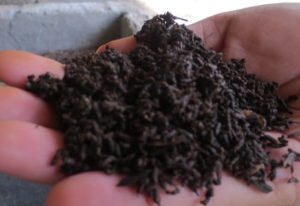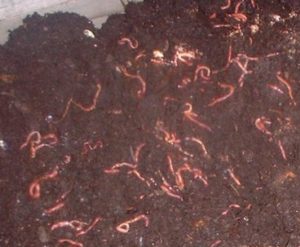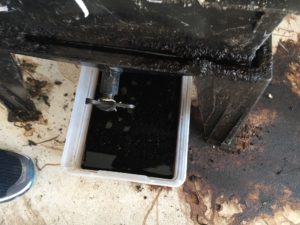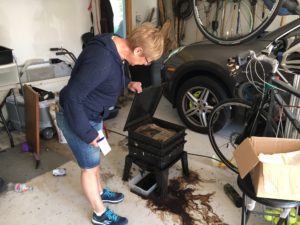Hello fellow readers, We spoke about a hot pepper crop grown in containers last week. Russ and Sara used worm castings added to their potting mix (link to the story below). “What are worm castings, and where do you get them?” asked Joe from Hope, NJ.

Worm Castings. Photo credit LeahLhey, CC BY-SA 4.0, via Wikimedia Commons
I’ll cut to the chase; Joe, worm castings are worm poop or worm manure to be more “proper.” And you can make your very own with worm composting. A bit of warning, you may consider reading this when you’re not having breakfast.
The benefits of worm castings
Worm castings increase soil’s ability to hold water and nutrients, which promotes plant growth. The ratio suggested is typically one-part castings to four-part soil or potting mix. Or you can spread a quarter or half-inch layer on top of garden beds.
There are worm composting farms you can buy that tout simplicity and cleanliness. They’re kind of pricey, though, ranging from 80 to 180 bucks. But you can build a DIY system for far less.
Rather than buy worming castings, why not make your own?
Also called vermicomposting, worm composting takes little space, and there’s no odor if done correctly. Any area that stays between forty and eighty degrees and is reasonably dark and dry works. So your basement, kitchen pantry, or even your bedroom will do.
Choose a container based on the amount of your kitchen waste. You can compost fruit and vegetable scraps, crushed eggshells, tea bags, and coffee grounds. Skip citrus, meats, dairy products, oily foods, and grains because of smells, flies, and rodent problems. Worms need about one square foot of surface area to digest each pound of waste per week. So a two-by-two-foot worm bin can handle about four pounds of scraps a week.
Whether a plastic tub or recycled wooden drawer, it should be eight to twelve inches high with several holes in the bottom for drainage. Raise the bin on bricks or wooden blocks, and place a tray underneath to capture moisture that serves as liquid fertilizer.
Fill three-quarters of the bin with shredded newspaper, chopped dry leaves, sawdust, leaf mold, or a combination thereof (even better) and moisten to the texture of a wrung-out sponge.
Add a couple of handfuls of sand or soil to provide the necessary grit for the worm’s digestion. Then add your food scraps. But always under the bedding material to keep the fragrance and flies at bay.
Red Wigglers are voracious eaters.
Next, come the worms. Specifically, Red Wigglers (Eisenia foetida), the most voracious eaters of the earthworm family consuming half their weight in food each day! You can buy them through garden supply catalogs. Experts recommend starting with two pounds of worms for a two or three-person household. Place a dark plastic sheet or burlap loosely on the bedding to conserve moisture and provide darkness for your worms.
It takes about sixty days for worms to turn kitchen scraps into castings, at which time you’ll need to separate them from the finished compost; otherwise, they’ll die. The process is called harvesting. The quickest way is to move the finished compost to one side of the bin, then place new bedding and food waste on the other side. The worms will gradually move over to the new site, making removing the finished compost easy to do.

A Worm Bin- Photo by Red58bill, CC BY 3.0, via Wikimedia Commons
Or, you can harvest all the compost by dumping the contents and separating the worms and tiny worm cocoons manually. Then mix a little of the finished compost with new bedding and scraps before returning your worms. Queasy yet?
How to prevent escapees
Worms can crawl out if conditions aren’t right; say, if the bedding is too wet or acidic. But don’t worry, they won’t go far before they wither up. But you may want to rethink the bedroom for your bin. :^) To prevent escaping, improve drainage by increasing holes or add a little garden lime.
Sure, you can buy worm castings. But be sure it’s from a reliable source and is a hundred percent earthworm manure (so proper) with no fillers. I’ve heard of castings filled with unwanted insects larvae wreaking havoc. Besides, by buying worm poop, you’ll miss out on all the fun. Garden Dilemmas? AskMaryStone@gmail.com (and on your favorite Podcast App.).
You can listen to this story and more in Episode 33 of the Garden Dilemmas Podcast.
Link to last week’s story – Growing HOT Peppers into cool Jelly and the column on my Birthday Reflection Pulse Check in case you missed it.
A Dear Client’s Worm Composting Set-up:
Nancy of Fredon, NJ, had one of the multi-tiered systems you can buy that touts the worms move to the next tray once they finish composting a layer, so you don’t have to separate the worms from the castings. And, there’s a lower tray with a spigot where the liquid collects for easy access to making compost tea. But that’s where Nany’s operation overflowed. The next time there, Nancy’s endeavor was gone. “Too messy,” she said. It goes to show sometimes DIY is better. Or have a larger bin for the overflow. :^)
A side note- This week’s post is a day late as I had the privilege of participating in a Pet Loss Butterfly Release Memorial Service hosted by Joseph T. Quinlan Bereavement Center and Abbey Glen yesterday (9/12/21). And so, today, it seems fitting to announce the most favored new column photo from all of you. Thank you, dear readers, for your kind support, Mary Stone








